The Intel SSD 320 Review: 25nm G3 is Finally Here
by Anand Lal Shimpi on March 28, 2011 11:08 AM EST- Posted in
- IT Computing
- Storage
- SSDs
- Intel
- Intel SSD 320
Overall System Performance using PCMark Vantage
Next up is PCMark Vantage, another system-wide performance suite. For those of you who aren’t familiar with PCMark Vantage, it ends up being the most real-world-like hard drive test I can come up with. It runs things like application launches, file searches, web browsing, contacts searching, video playback, photo editing and other completely mundane but real-world tasks. I’ve described the benchmark in great detail before but if you’d like to read up on what it does in particular, take a look at Futuremark’s whitepaper on the benchmark; it’s not perfect, but it’s good enough to be a member of a comprehensive storage benchmark suite. Any performance impacts here would most likely be reflected in the real world.
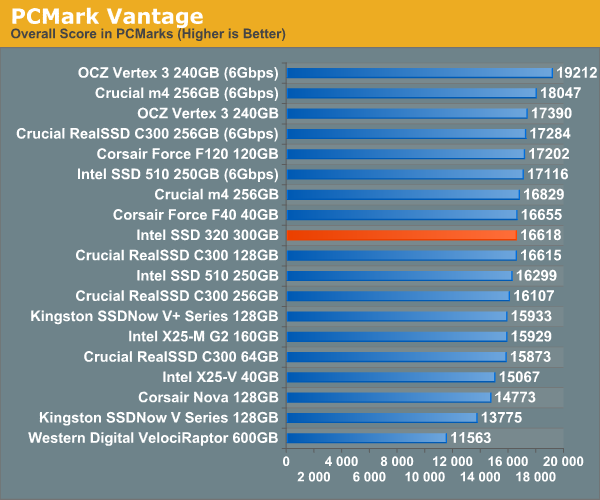
The 320 falls in the middle of the pack - around the performance of a SF-1200 drive like the Force F120 but no where near what you'll get from a 6Gbps Vertex 3.
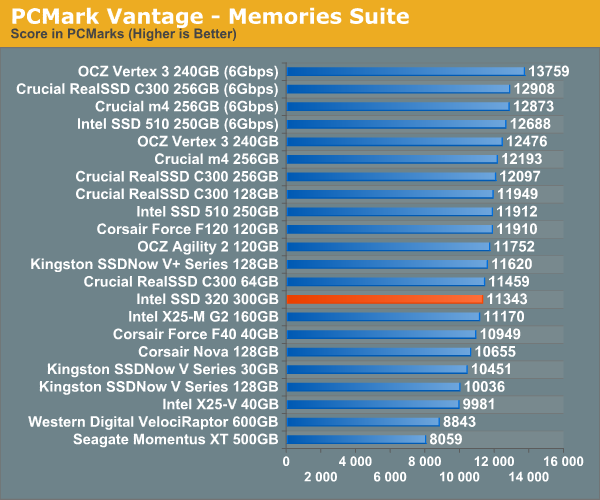
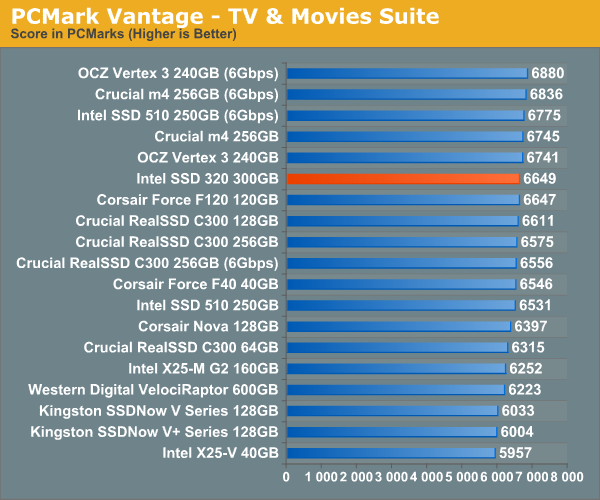
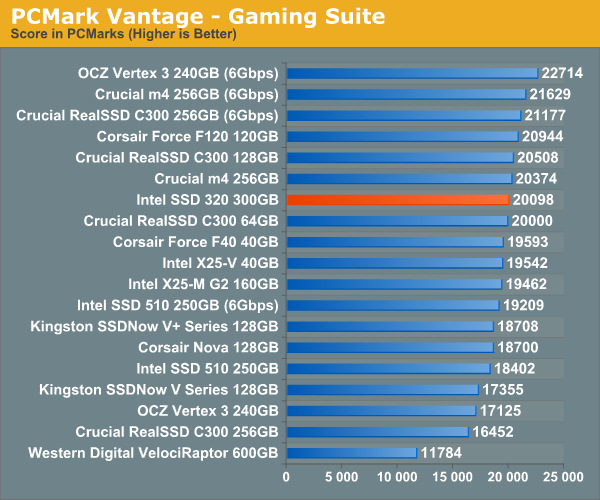
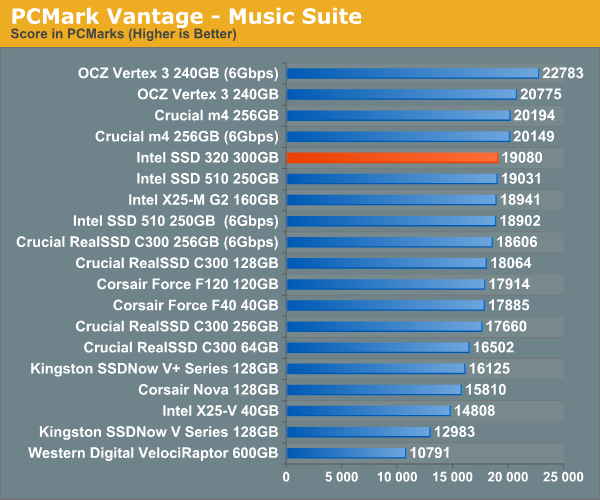
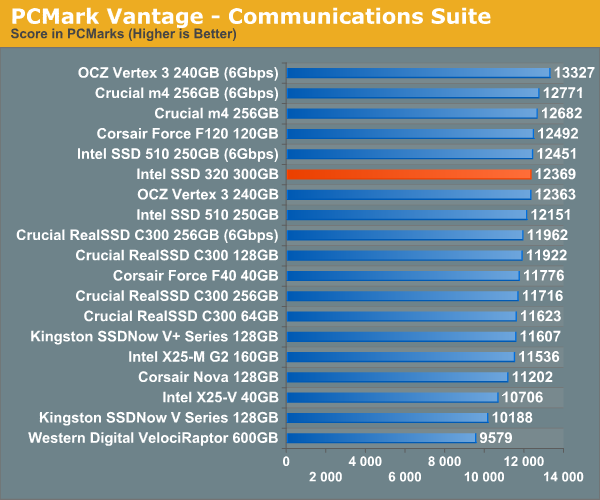
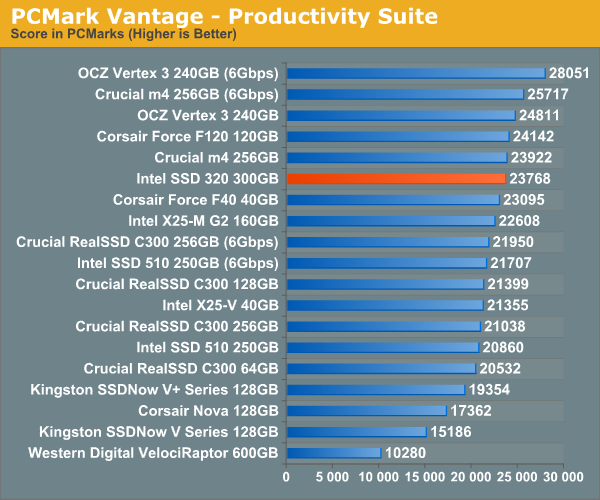
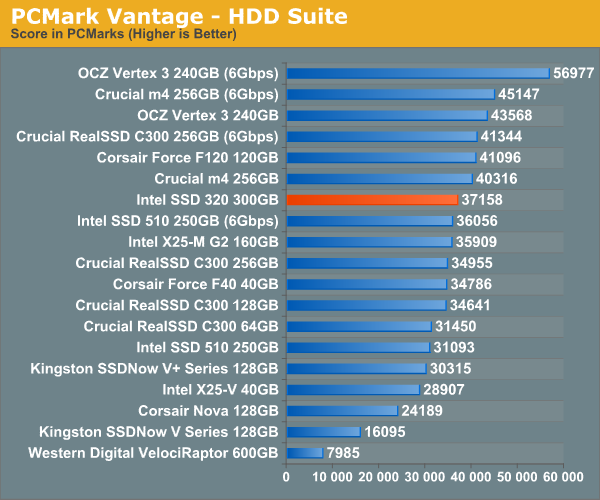










194 Comments
View All Comments
Chloiber - Tuesday, March 29, 2011 - link
True.It is true, thet the REAL capacity of flash drives is 2 based. The NAND chips are.
So a 120GB drive has in reality 128GB of flash.
So its 120/128 % spare area. The 300GB version has also 300/320 % spare area (which is exactly the same).
Anand is confusing things. The user gets 300GB, as he gets 300GB when buying a HDD. Windows on the other han is showing us "GiB" not "GB". But it's not a real difference in size. 74.5GiB EQUALS 80GB. It's the same thing. Compare the BYTE numbers if you wanna be sure, not the KB/MB/GB/TB numbers.
I'm actually shocked that this still gets confused.
overzealot - Tuesday, March 29, 2011 - link
RAM was not the only thing that was calculated using binary pseudo-metric prefixes. Perhaps you aren't old enough to remember the days before kibibytes, when all computer disks and tapes were measured as such.noblemo - Wednesday, April 6, 2011 - link
Conversion from GB to GiB:320 / 1.024^3 = 298 GiB
Subtract 6.25% spare area:
298 x (1-0.0625) = 279 GiB
MeanBruce - Monday, March 28, 2011 - link
You can blather all the technostats you want 25nm, who cares, didn't change a thing! My next ssd, would never have said this a year ago, looks like Corsair Force GT! Read/Write 500/500 is all you need to say!;)zanon - Monday, March 28, 2011 - link
Granted, this isn't a stunning offering. But one thing I do look forward to is that I think we will finally start to see updated filesystems start to appear in the near future. For example, ZFS appears as if it will at last appear as a full Mac OS X file system via Z-410 this summer.One of the features of modern filesystems is full filesystem level compression and encryption (which really is where such features belong). I will be looking forward to (hopefully) seeing you test how this affects the SSD scene. My principle concern with Sandforce's strategy in the back of my head has always been this: that sooner or later, OS makers or someone will finally get with it and make full compression standard in the FS. At that point, the "worst case" scenario of fully random data will become the *only* scenario. That still leaves a (huge huge) legacy market, and likely time to adapt, but I do wonder if it will shake up the SSD scene at all once again.
overzealot - Tuesday, March 29, 2011 - link
I don't agree. If the controllers are powerful enough to do encryption and compression in real-time, then it should still be done at the disk level.You can still encrypt/compress in your OS as you please, but I like having performance.
PS, not dogging on ZFS, I use it all the time with openindiana.
marc1000 - Monday, March 28, 2011 - link
vertex 3 is not already on market???http://www.amazon.com/OCZ-Technology-Vertex-2-5-In...
aork - Monday, March 28, 2011 - link
That's for pre-order. Notice "Usually ships within 1 to 2 months."piquadrat - Monday, March 28, 2011 - link
Is it sufficient, security wise, using only max. 8 characters ATA password against thieves?One program, I sometimes use, MHDD offers ATA password reset option.
If someone can bypass ATA pass so easily what all this AES128 is for?
Could someone explain this matter to me?
DesktopMan - Monday, March 28, 2011 - link
The password is used to generate the encryption key, much like how software products such as TrueCrypt does it.The max length of ata paswords is 32 which should be more bits than the actual key, depending on character set. 8 is not much though, depending on how these drives deal with brute force attacks.
Old drives with ata passwords are just enabled with the password, which can be circumvented with master passwords or firmware commands in some cases.